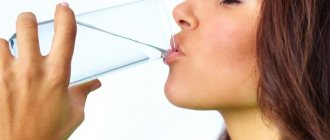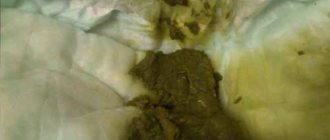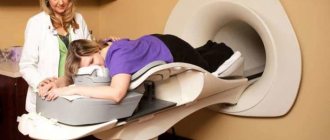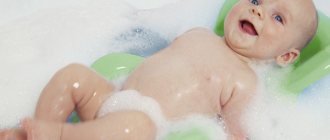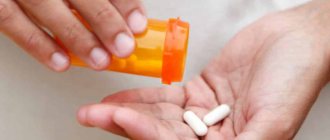What if a woman has flat nipples before or after giving birth? How can I improve the situation? You can get completely contradictory information from different sources.
Some express the opinion that nothing should be done before the baby is born, others give recommendations on wearing special nipple formers (however, wearing nipple formers can provoke a miscarriage, as the mammary glands are stimulated). And some experts suggest massaging the nipples.
In general, there is an opinion that flat nipples do not have any negative effect on breastfeeding.
Sometimes the ability to choose the right position before lactation is of great benefit. The position “from under the muscle cavity” is considered very good. Some expectant mothers are told by doctors, without any reason at all, that they have flat nipples and may have problems with feeding.
This is a myth, since the baby does not attach to the nipple, but to a large area of the breast. The nipple is a kind of beacon for finding the breast. In addition, in a larger number of expectant mothers, during the period of bearing a child, the shape of the nipple changes and becomes more voluminous. And when the baby attaches to the breast, the nipple becomes more elongated.
A woman just needs to read materials on how to breastfeed and try not to offer her baby a pacifier or bottle, then there will be no problems with feeding. If the nipples are retracted, then the situation is a little more complicated, since if the nipple does not extend at all, then there is no stimulation of the baby’s palate during feeding. During the feeding period, the baby creates a vacuum with his mouth, and the nipple comes out, but this may not give the most comfortable sensation to the mother, and besides, the baby must somehow begin to suckle at the breast. Therefore, if a woman has an inverted nipple, then she should not, if possible, give her newborn a bottle or an elongated nipple. It is unlikely that the child will want to suck on a less comfortable nipple after this.
Why are nipples flat?
There may be several reasons:
- Lack of balance between the tension of the milk flow and the traction of the nipple tissue.
- Pathological processes in the reproductive system.
- Underdeveloped milky streams.
- Tumor process in the chest.
- Pathologies of the mammary glands.
- Wearing a smaller bra for a long time and not following the rules for caring for the mammary glands.
- Heredity. If your grandmother or mother had flat nipples, then most likely the heiress will have them too.
Often this is a congenital deviation from the norm, which does not bring discomfort or pain to the woman, but some experience psychological discomfort or problems when putting the baby to the breast. However, with modern medicine, all these problems are easily solvable. There are several methods for correcting the shape and size of the nipples: surgical and non-surgical. There are two options for surgical correction (with or without preservation of milk flows). The first option is cheaper, but in this case the woman will not be able to feed, the second is more expensive and the flow is maintained, lactation remains possible. Non-surgical methods for nipple traction will be discussed below.
Non-surgical treatment for inverted nipples
To correct inverted nipples, non-surgical treatment can be used using a special vacuum attachment applied to the mammary gland. The nipple is lubricated with Vaseline to seal it, the air is pumped out from the nozzle, and the cup of the nozzle is fixed on top with a surgical plaster.
The vacuum attachment is worn throughout the day, removed to inspect the breast for cracks and irritation. Over the course of several weeks of treatment, the short bundles of connective tissue lengthen and the nipple is pulled forward. However, with tightly inverted nipples, even long-term use of the hardware technique is ineffective. Vacuum nipple traction may be recommended for patients at the preoperative stage.
Radical correction of the shape of inverted nipples is performed using plastic surgery.
Breast shaping before breastfeeding
To determine whether the nipple is inverted, you need to press on the areola, just above and below the nipple. If it goes inward, then this means the shape of the nipple is retracted. And if the nipple comes forward, then it is normal. For those women whose nipples are inverted, wearing nipple shapers is absolutely useless. However, if wearing the devices does not bring discomfort to the expectant mother, then the shapers can be worn. If a woman is nervous or worried, then it is better to refuse to wear shapers. There is no particular point in carrying out such preparatory measures; the nipples will change shape before the birth of the child, and even after the birth, when the baby eats, he himself will form the nipples as they should.
The baby helps correct the situation if a woman has flat nipples or inverted nipples. Doctors agree that the most important point is to eliminate the long nipple and bottle for feeding the baby.
After birth, the child studies the mother’s breast and will definitely begin to suck on it, regardless of the shape of the nipple. This will happen unless the mother offers him an alternative in the form of a pacifier and a bottle. The baby sucks not the nipple, but the breast. A correct chest grip should be at 150 degrees, an incorrect chest grip should be at 90 degrees. A doctor should show you how to feed your child correctly.
The nipple does not play a role during the feeding process itself; the baby expresses milk from the breast by pressing the tongue on the nipple, and then sucks it into itself using a vacuum. In some cases, breast shaping is still useful, and special devices such as:
- breast pump;
- cut syringe;
- vacuum extractor.
If possible, doctors recommend consulting with a breastfeeding specialist who will tell and teach you how to feed correctly so that the milk does not disappear, and so that the woman and baby feel comfortable during this magical ritual.
The specialist will show you the correct position, help shape your breasts for breastfeeding, and tell you what measures to take if the mammary glands are swollen, swollen, or hardened. If the breasts are rough, it will be difficult for the baby to latch on.
Solving the problem of breastfeeding with inverted and flat nipples
Every woman is unique. And this manifests itself in everything - in appearance, character, temperament, skin color, eyes and hair, figure, size and shape of the breast. In this article we will talk about the different shapes of the nipple.
Women's nipples can be different - inverted, flat, large, small, long, short. And, in this regard, women always have a question: “Will I be able to feed a child with my nipples of an “irregular” shape?” And here it is very important to understand that there is no correct breast shape. For success in breastfeeding, it is not the shape of the nipple that is important, but the ability of the skin around the nipple to stretch.
At the end of the article we have prepared additional information for you. material - video of a pediatrician with 20 years of experience, about how to properly introduce complementary foods to a baby and a step-by-step feeding schedule.
Based on this property, the following types of nipples are divided:
- Normal - when, when pressing with the index finger and thumb on the circle of the areola, the nipple protrudes significantly outward.
- Flat - it will not react when pressed.
- Retracted - when pressed, it is pulled inward.
However, when the baby is born, he does not know that you have some different breasts, with some different nipples. For him, his mother’s breast is the only true and correct one. The baby will breastfeed with any nipple!
How does the baby suckle?
Immediately after birth, babies have an innate expectation of breastfeeding. If the baby is placed on his tummy between the mother's two bare breasts, he will be able to crawl to the breast and latch on. Children navigate by smell! The glands located on the areola secrete a secretion similar in smell to amniotic fluid. And the dark area of the areola is for them a distinctive spot on the mother’s lighter breast. Newborn babies are drawn to it intuitively. And at this moment the nipple is a reference point for the baby - the breast must be grasped by this particular area! And the very mechanism of a child’s sucking of the breast is such that he sucks not the nipple, but the areola. A significant part of the areola should be in the baby’s mouth, approximately 2-3 cm from the base of the nipple.
To release milk from the breast, you need to stimulate an area within a radius of several centimeters from the nipple, which is what babies do - they press on the areola with their gums and push the milk through the milk ducts with their tongue to the nipple, and then into their mouth.
Organization of feeding with inverted and flat nipples
However, mothers with inverted and flat nipples need to be more patient in organizing the correct latch of the newborn to the breast and take into account several points:
- Immediately after the baby is born, place it on your breast, excluding the baby's introduction to the bottle before breastfeeding. Bottle sucking is easier! The technique of sucking a bottle is fundamentally different from sucking a breast. If the baby sucks the breast like a bottle, he will not be able to get the required amount of milk from the breast, will begin to think that it is much easier with a bottle, and will refuse the breast. For the same reason, do not use pacifiers.
- Feed on demand, avoiding overfilling. Don't hoard milk. On an overfilled breast, the areola becomes dense and inextensible, which makes it even more difficult for the newborn to latch on.
- Hold your breast with your hand throughout the feeding to prevent your baby from losing it from his mouth.
- Feed in comfortable positions that allow for a deep latch.
Breastfeeding positions with inverted and flat nipples
Feeding from under the hand (from the armpit).
Positions for feeding a newborn after a caesarean section.
In this position, it is very convenient to control the baby’s grip on the breast, preventing him from moving off it. Sit on a sofa, chair or bed. Place a pillow on your knees. Place the baby on it with its side facing you, on your hip. Its legs are bent and are located at your fingertips. Use the palm of the hand next to which the baby is lying to hold his head. The forearm of the hand is along the baby’s back. Offer your breast to your baby with your other hand and be sure to support it during feeding.
At the end of the article we have prepared additional information for you. material - video of a pediatrician with 20 years of experience, about how to properly introduce complementary foods to a baby and a step-by-step feeding schedule.
Another great position that provides maximum control over the baby while he is at the breast. Take a comfortable sitting position. Place a pillow on your knees under your arm and at your side. When feeding from the right breast, place your left hand on the back of the baby's head. Your thumb and index finger are behind your baby's ears. The baby's neck is freely located in the area between the thumb, index finger and palm. The palm itself is between the baby’s shoulder blades. Use your other hand to latch onto the breast and support it during feeding.
Pull?
If you see that your baby is having a hard time latching onto your breast, don’t despair. There are several methods for correcting the shape of the nipple. This will require a little extra effort on your part. So, what can you use to “stretch” your nipple?
Nipple formers.
These are small convex cups with one large hole in the center and several small ones on the periphery. Nipple formers are inserted into the bra and positioned around the nipple. Light pressure is created on the connecting muscles of the chest and the nipple is pulled out through the central opening. The remaining holes provide ventilation to the breasts, keeping the nipples dry. It is recommended to use them 20-25 minutes before feeding. These “chest shells” can be worn during the last three months of pregnancy, gradually increasing the wearing time to 8 hours in a row. They are absolutely harmless and completely invisible to others.
Breast pump.
You can resort to its help immediately before feeding. Within 30-60 seconds of pumping, the nipple is stretched, and the baby is already better attached to it, and most importantly, the nipple is properly attached. And the milk pumped out by a breast pump can be collected and used, for example, to create a milk bank.
Hoffman technique
This method removes the base of the nipple and makes the areola softer. To use this technique, place your thumbs on either side of the nipple of the breast you will be feeding. Stretch the breast skin to the sides with your fingers using stroking, slightly pressing movements. Move your thumbs, placing them both above and below the nipple. Use this method a few minutes before you start feeding.
And now, good news: the nipple, in the process of sucking, gets used to stretching and physiologically takes on a more elongated shape! This takes 4-5 weeks. And as you continue to breastfeed, you will one day not remember that you had “irregular” shaped nipples.
If you have confidence in your natural ability to breastfeed your child, you will definitely solve all your problems and breastfeeding will be a joy for you.
viline.tv
What to do if you can't give a bottle?
During the feeding period, the nipple stimulates the baby's palate and the sucking reflex. Therefore, if the baby received a pacifier or bottle before being put to the breast, he may not like being offered something else as a stimulant; he may be dissatisfied with flat nipples. The baby may refuse to breastfeed, so sometimes you have to take a number of additional measures. It is necessary to feed the baby from other items, such as:
- cup;
- spoon;
- pipette.
During the period of such feeding, it is necessary to gradually put the baby to the breast for additional feeding, and express milk for the main feeding. If this method does not give any result, then some women use special covers for flat nipples. These devices should be very thin, this will help to avoid a shortage of milk. In addition, you need to monitor your breast latch so that feeding takes place in a classic position, otherwise the woman may experience pain and the mammary glands will not be completely emptied. And yet, overlays should not be abused, as they can lead to serious consequences, such as:
- colic;
- low weight of the child;
- decrease in mother's milk supply.
In addition, the pads must be sterilized all the time; they cause discomfort. It is necessary to purchase high-quality, expensive pads with a cutout so that there is tactile contact between the baby and the breast.
Surgery to correct inverted nipples
Before planning plastic surgery to correct an inverted nipple, the patient must be carefully examined, since a change in the shape of the nipple may indicate a number of serious pathologies of the mammary gland, including a breast tumor.
To select the necessary method of plastic correction of inverted nipples, the patient needs to decide whether she plans to breastfeed in the future, since depending on this, the integrity of the milk ducts can be preserved, or the operation will be limited to correcting a cosmetic defect.
Correction of inverted nipples is a relatively minor surgical intervention and can be performed under local or general anesthesia. If breastfeeding is not expected in the future, then during the operation the bundles of connective tissue that hold the nipple are cut, which is accompanied by its lengthening. True, this also involves crossing the milk ducts, making it impossible for the child to subsequently breastfeed.
To preserve the integrity of the milk ducts and their function, microsurgical correction of the nipple is performed. Through a small incision at the base of the areola, using a microscope, only the connective tissue cords pulling the nipple inward are carefully dissected. At the same time, the integrity of the milk ducts is preserved, the nipple is pulled forward, which ensures the possibility of subsequent breastfeeding.
Correction of inverted nipples can be carried out either independently or in combination with mammoplasty (breast lift or reduction). The duration of the nipple correction surgery is about one hour. With isolated correction of inverted nipples, which is not accompanied by a change in the shape and size of the breast, recovery after surgery occurs quickly.
Swelling and bruising go away after a few days, the stitches heal almost without a trace, and within a few weeks a decrease in nipple sensitivity may be observed. Postoperative restrictions include the exclusion of significant physical activity, visiting the sauna, solarium, and the beach for several months after nipple correction. The aesthetic results after correction of inverted nipples are usually long-lasting.
Inverted nipples are a violation of the normal development of the nipple-areolar area of the mammary gland, in which the nipple is placed in the same plane with the pigmented area of the breast (areola), that is, it does not protrude.
In order to understand the main reason for the formation of such a defect, a woman must know the elementary basics of the structure of the mammary gland. During normal formation, the female breast has more than 20 milk ducts, which stretch from the deep layers of the mammary gland to the nipple, where they are attached with the help of connective tissues. In the case when the length of the milk ducts is insufficient, the nipple is retracted into the depths of the areola.
In medicine, the defect of inverted nipples is diagnosed relatively rarely - in approximately 10% of female representatives. In addition to the fact that the presence of such a defect causes aesthetic dissatisfaction with the shape of a woman’s breasts and negatively affects her emotional and psychological state, an inverted nipple also interferes with such an important physiological function as breastfeeding. Breastfeeding problems are caused by the fact that the child is simply not able to properly position the breast in the mouth and fully perform the sucking function, which plays an important role in the formation of the child’s bite.
Another problem faced by women who have the problem of inverted nipples is inflammation or swelling of the areolar region; also, pathogenic bacteria can accumulate in the recess of the inverted nipple, which can cause infectious diseases.
If a woman has developed an inverted nipple, this may be a serious reason to contact a specialist, because nipples can become retracted due to the formation of tumors in the mammary gland.
Investigating the problem of inverted nipples, experts have identified a number of reasons that have a primary influence on the formation of this defect. In addition to those described above, these include:
- pathologies in the work and development of the reproductive system of a woman’s body;
- underdevelopment of the milk ducts, which causes an imbalance between them and the tissues of the nipple;
- prolonged use of a tight bra.
Often, pathology in the form of an inverted nipple appears in adolescence during the formation of the mammary glands and is congenital. If after 18 years the defect has not been corrected independently, then it is necessary to seek qualified help.
Breast stretching devices
The following devices will help to form the correct shape of the nipple:
- Silicone pads. The main purpose of the shield is to protect the nipple and areola from cracking. But, as mentioned above, it is not recommended to use pads, since when feeding with them there is no high-quality stimulation, as a result, the amount of milk decreases sharply. In addition, the skin under the pads is constantly drying out, and it’s unlikely to be possible to stretch out the nipples with the help of them. Attention! If you do use pads, then you can’t put the convex part into the baby’s mouth when feeding, you just need to pass the very tip over the lips and the baby’s reflex will work and he will start sucking at the breast. For feeding with the shield to be successful, it must not only be applied to the nipple area, but put on the nipple. To do this, it is recommended to run ice over the nipple so that it becomes tense, after which you can easily put the shield on.
- Vacuum puller. It works on the principle of a syringe, only the tip does not have the usual needle, but a special cap of different diameters, which is applied to the nipple and pulls it out. This pulling method has a number of disadvantages. Firstly, you cannot use it in the 1st and 3rd trimester, and secondly, it is quite expensive. Doctors recommend replacing the puller with a breast pump; the money will be the same, but the breast pump will be useful in the future for pumping. Some women pull out their nipples with a regular syringe; they simply first cut off the tip for the needle attachment.
- Seashells. This device looks like a plastic hemisphere, sometimes with holes. In the center of the hemisphere there is a silicone circle with a hole for the nipple. The circle is applied to the mammary gland and thus the nipple falls inside the hemisphere. This device is not harmful, it can be worn throughout the entire period of pregnancy, there are no contraindications. But, unfortunately, it does not always pull out the nipples; the effect is minimal. Shells can be beneficial already during feedings, as they collect drops of milk.
We select the shape of the nipple: classic, anatomical, orthodontic
Nipples come in classic (round) shapes and anatomical ones. The round shape of the nipple is the most common and familiar shape to everyone. This is a pacifier that is narrow at the stopper and gradually widens towards the end, with a rounded papilla. This pacifier can be given to a child in any direction. But with very frequent and long-term use of such a pacifier, an incorrect bite may form.
Anatomically shaped nipples correspond to the structure of the baby's gums. This is a nipple adjacent to the tongue, flattened on one side, having an ellipsoidal shape. This shape of the pacifier allows you to evenly distribute pressure on the palate of the newborn. The anatomical nipple prevents the swallowing of air and helps the correct development of the bite.
Photo of a regular and anatomical nipple (Clickable):
Regular nipple shape Anatomical shape
There are also orthodontic pacifiers.
Orthodontic pacifiers
The most popular now is the orthodontic pacifier. This is a nipple with an oblique papilla, slightly flattened on one side and convex on the other. Thanks to its teardrop shape, it fits more comfortably in the mouth. The baby grabs it just like his mother's breast. According to their shape, orthodontic nipples are divided into 3 types:
- “Cherry” is a special form of pacifier intended for “heroic” children with a big palate.
- “Heart” is a nipple used to form a bite.
- “Butterfly” is a pacifier for sucking while lying on the stomach.
Another type of nipple that is flat on both sides is called symmetrical. This pacifier is convenient because, like a round pacifier, it can be placed on either side in the baby’s mouth.
With all the wealth of choice, it is difficult to guess what form of pacifier a child will choose. It is believed that he chooses the shape that the mother's nipple takes in his mouth.
Photos of different nipples:
Video: how to choose the right pacifier for a child
Choosing a pacifier size
There is a generally accepted classification of nipples by size. It consists of 3 categories: size A (from 0 to 6 months), size B (from 6 to 18 months), size C (from 18 months).
Some companies produce pacifiers for little ones with the following division:
- For newborns weighing less than 1750 g;
- For babies from 0 to 3 months;
- For children from 3 to 6 months;
- For toddlers from 6 months.
It is necessary that the size of the nipple always increases with the growth of the child. Of course, the division of nipples is very arbitrary. The correct choice of size should depend on the individual physical characteristics of the newborn. If the baby is smaller than his peers, then you should not give him a large pacifier, otherwise he will choke. And if the toddler grows faster than his peers, then the appropriate pacifier must be selected, because A small one can cause bite problems in the future.
Read also…. Proper nutrition for children
We decide on the material: rubber, latex or silicone
When choosing a pacifier, the material from which it is made is also important. Nipples can be made of rubber, latex and silicone.
The rubber pacifier is a pacifier that is gradually becoming a thing of the past. Rubber may cause diathesis on your baby's cheeks and lips. This pacifier is also very short-lived. However, when teeth begin to cut, a rubber pacifier is best suited.
Modern nipples are made of latex or silicone.
The latex pacifier is made from natural rubber, which makes it soft and elastic. More suitable for newborns in the first months of life and recommended for weak and premature babies. The color of the pacifier can be transparent or light brown.
The disadvantages of this pacifier include:
- Unable to tolerate high temperatures, such as boiling;
- It darkens when exposed to sunlight;
- With prolonged use, it sticks together and increases in volume;
- Latex contains protein molecules, which can sometimes cause allergies.
The latex pacifier should be changed every 4 weeks.
A silicone pacifier is considered safer than a latex pacifier, because... more resistant to disinfection (boiling). This nipple is made of synthetic material, elastic and elastic. This pacifier has no smell or color. It does not cause allergies. However, this pacifier is harder than latex and can cause deformation of baby teeth. Therefore, it is recommended to use this pacifier until teeth appear. Silicone nipples need to be changed every 6 weeks.
Regardless of the material, the pacifier must be made from one piece. Then the newborn will not be able to tear it apart during sucking and not choke.
A little about the base of the pacifier
Any pacifier consists of a shield (base), a nipple and a ring. This design is safe because It is a single piece that cannot be taken apart. Before purchasing a pacifier, you need to make sure that the shield is the right size for your baby. It should be wide to avoid accidental ingestion.
Ring-shaped restraints in most cases put pressure on the child’s nose. Therefore, it is important that the shield has a recess (cutouts) for the baby’s nose.
The presence of holes for ventilation in the base of the pacifier is mandatory. They are necessary to make it easier for the child to breathe.
A big plus will be the textured inner surface of the base. Such a shield will not fit tightly to the skin. Otherwise, saliva may accumulate under it, which can cause irritation on the chin.
To avoid breakage, it is desirable that the base of the pacifier be monolithic.
Several techniques for stretching flat nipples
As already mentioned, flat nipples can cause problematic feeding of the baby. It is better to prepare for lactation while pregnant. The whole pulling technique is that you need to hold the mammary gland with one hand, and with the other, take the nipple with your thumb and ring finger and begin to gently twist it. You need to do this exercise for about half a minute on each mammary gland. Another effective nipple stretching exercise is the following:
- Place both ring fingers on the nipples on the left side and move them to the base of the mammary glands.
- Place the same fingers on top and do the same, move your fingers to the base of the chest.
- Place your fingers on the bottom and do the same steps.
This exercise should be done morning and evening, for a minute. If your nipples are very inverted, then it is better to consider using breast shields or consider pumping breast milk abundantly and frequently. While pregnant, doctors recommend doing an exercise to squeeze the nipples with two fingers, in the horizontal and vertical plane. This exercise will help to form an adequate nipple response. You need to do this exercise for 2-3 minutes.
Another way is to twist the nipples in one direction and the other through gauze. Twisting should be done 2-3 times a day. You can try to pull out the nipples using a breast pump; the device, in a discharged state, with the tube tightened, is left on the chest for half an hour. The procedure must be performed 3 times a day. However, we must not forget about the threat of miscarriage.
A woman must understand that if the pregnancy is difficult, there is a threat of miscarriage, she was hospitalized several times for preservation, then touching the nipples is strictly prohibited.
Any manipulation of the nipples can cause a miscarriage.
Moreover, flat nipples are not such a pressing problem. The most important thing is to discuss any actions with a doctor, who will tell you how to act correctly in the current situation, then both mother and baby will be happy.
How to stretch out nipples
Preparing the breasts for feeding can begin during pregnancy. Just keep in mind that nipple stimulation leads to uterine contractions, which can cause premature birth. Therefore, any of the listed actions can be carried out only after 38 weeks, after consulting with your doctor.
Manual nipple stimulation
Squeeze the nipple at the base with your index finger and thumb and pull lightly. To change its shape, it is enough to carry out a similar procedure for a few minutes in the morning and evening. Also, try twisting the nipple in one direction and the other. It is important to be careful not to overdo it as this area is very sensitive. Any painful sensations are unacceptable. Also keep your hands clean or use sterile gauze pads. Another method of stimulation is cold massage. Take an ice cube and rub it over your nipple to make it swell and stretch out.
Nipple covers
There are two versions of such devices on sale. The first are silicone imitation nipples and are intended to prevent the occurrence of cracks during feeding. There is no consensus among doctors regarding the need for their use, but they actually save many women by helping to stretch the nipple. The main disadvantage is that they prevent access of air to the skin, so they cannot be worn for a long time.
The second format of the overlays has the shape of a hemisphere with small holes. Their main purpose is to collect dripping milk during lactation. They are considered safer because they do not interfere with the free circulation of air, and the chest does not sweat in them. Such pads can be used during pregnancy or between feedings, inserted into a bra. They are made of soft silicone, so discomfort is minimal. But, unfortunately, their effectiveness is somewhat lower.
Nipple traction devices
A special device with a piston is designed for these purposes. You can make it yourself from a syringe of the required diameter, cutting off the front part from it. Using a piston, a vacuum is created and the nipple is forced forward. A breast pump can also come to the rescue. It is great for women with flat nipples, as it helps to correct their shape due to the vacuum mentioned above. In addition, it is possible to store milk for the future by freezing it in sterile containers.
How to restore breasts after feeding
The right diet
For more productive restoration of the mammary glands after lactation, the following products will help to enrich your diet:
- any lean meat;
- milk, at least two glasses a day;
- fish fat.
Physical exercise
Exercises to restore breast elasticity and height are as follows:
- Push-ups with arms wide apart - 10 times, 3-4 sets.
- The starting position is lying on your back with your knees bent. Hands with dumbbells are spread to the sides and lowered to the body. The exercises are repeated alternately 10-15 times.
Massage
Massage helps restore skin tone and elasticity. The technique consists of the following manipulations:
- stroking circular movements on the mammary glands;
- intense chest kneading;
- massage with fingertips;
- patting the chest with the ribs of the palms.
We have a detailed list of products for a nursing mother in our article.
What is possible and what is not!? Find out what sedatives you can use when breastfeeding here. Soothing teas are the best remedy!
Cold and hot shower
Procedures with alternating hot and cold effects strengthen the walls of blood vessels, increase tissue elasticity, and improve blood circulation. It is enough to apply a shower jet to your chest alternately with hot and cold water for 10 seconds.
The success of lactation largely depends on how well a woman prepares her mammary glands for future feeding. We should not treat this issue with disdain, despite the fact that nature has thought through a lot for us. Simple manipulations will help maintain not only the health, but also the beauty of your breasts.
How to make breastfeeding easier
Compliance is another way to correct flattened nipples. In case of slight flattening of the nipples, it is recommended to follow the technique of attaching the baby to the breast without the use of auxiliary devices.
- The baby should be given the breast when he opens his mouth completely. This will ensure complete coverage of the nipple and part of the areola.
- Before each time you put your baby to the breast, it is recommended to stimulate your nipples. For this purpose, you can use a vacuum device, a breast pump or self-massage techniques.
- Unsuccessful attempts to latch on to your baby are not a reason to stop breastfeeding. With each new attempt, the shape of the nipples will change noticeably.
- Before putting your baby to the breast, it is recommended to do a little pumping. This will make the mammary gland softer and more pliable.
- A nursing woman needs to experiment daily with feeding her baby. The newborn can sit on top of the mother. This position alternates with a pose when a woman feeds her baby while lying on her side.
- Tactile contact is necessary between the child and the nursing woman. When feeding, a woman is advised to free her upper body from clothing so that the baby can feel the mother's skin. This condition is necessary to stimulate the search-sucking reflex in the infant.
- When feeding a baby, breast milk leaks form, which must be wiped off with a clean cloth or napkin. If this is not done, the baby’s lips will constantly slip and lose the nipple.
The emotional state of a nursing woman plays a significant role in maintaining breastfeeding. To provide your baby with emotional comfort, it is recommended to follow these rules:
- 15 minutes before the next feeding, it is recommended that the mother take the baby in her arms. This helps to establish tactile contact between mother and child.
- A nursing woman should relax her body as much as possible before feeding. For this purpose, it is recommended to take a warm shower or bath, perform self-massage of the chest, turn on pleasant music, or lie down for a few minutes in complete silence.
- Self-massage techniques will help to relax the mammary glands and correct the shape of the nipples. To do this, it is recommended to perform stroking techniques and lightly kneading the mammary glands. The influence on the nipples is carried out with the thumb and forefinger. To do this, the woman must slightly squeeze them and pull them forward. Before the massage you need to take a warm shower. The husband of a nursing woman, who will take on the role of a massage therapist, can provide assistance in this matter.
The presented methods for correcting inverted and flat nipples will help a nursing woman get rid of this problem once and for all in a short time. If self-correction does not produce a positive effect, then a nursing woman should seek advice from a breastfeeding specialist.
With the beginning of the breastfeeding process, quite often young mothers face various kinds of problems. One of the most common is an irregularly shaped nipple. As a rule, in such cases the baby cannot grasp it normally, as a result of which he is constantly nervous and cries. The feeding process turns into torture for a woman. Let's take a closer look at this situation and try to answer moms' question: how to stretch out flat nipples for normal breastfeeding.
How is it carried out?
As a rule, such an anatomical feature of the mammary gland as a flat nipple does not require any special therapy. Every nursing mother must remember that for the correct feeding process it is necessary to monitor the latch on the breast, i.e. observe correct application. So the baby should grasp with his mouth not only the protruding tip of the nipple, but also the entire areola.
In cases where this is impossible (nipple or too much), special exercises can come to the mother’s aid. Doctors often recommend starting to perform them while the baby is pregnant, in the later stages (37-39 weeks). So the woman should rhythmically squeeze the nipple between her thumb and forefinger at its very base. The procedure must be carried out 2 times a day, for 3-5 minutes. Such exercises will not only help correct the shape of the nipple, but will also stimulate the beginning of the birth process.
What devices are used to change the shape of the nipple?
Also, in addition to physical exercises of this kind, when answering the question of how to stretch out inverted nipples at home, doctors recommend using so-called nipple shapers. This device is made in such a way that it is put on the breast in the nipple area and worn under underwear. In this case, the size of the underwear itself should be one size larger than what the woman usually wears. The product itself is selected taking into account breast size.
Thus, you can stretch the nipple for feeding on your own, but before embarking on such a correction, you should consult with a specialist.
But flat or inverted nipples can make feeding a toddler difficult. However, it is worth remembering that even if you have nipples of a non-standard shape, you can breastfeed if you wish.
Those with inverted or flat nipples worry about this not only during pregnancy and after birth, but also long before that. After all, every girl understands that breastfeeding will cause inconvenience to both her and the child.
How to prepare your breasts for feeding
The mammary glands are designed by nature to enable a woman to feed her offspring. No special manipulations are required when preparing the breast. However, medical recommendations apply to the following range of actions:
- preparing the breasts for lactation while expecting a baby;
- preparatory activities after childbirth;
- hygiene procedures;
- massage;
- exercises.
Which pills are best to choose to stop lactation?
All answers to the question about stopping lactation. Read reviews about breastfeeding pads here. Find out the pros and cons!
What should women with flat nipples do?
Many expectant mothers worry whether the baby will be able to breastfeed, whether he will go hungry, or how to tell if the baby is full. What causes women particular concern before the onset of lactation is that they have flat nipples. Doctors say that before breastfeeding begins, it is necessary to harden and develop the mammary glands. You need to learn how to attach your baby and hold him facing your chest.
Exercises you can do include:
- Grasping the nipple with your fingers and pulling it out.
- Massaging the breasts by pinching. It is not recommended to touch the areola, as this can lead to premature birth.
- Lightly squeeze the nipples between your fingers.
Some mothers are simply afraid or do not want to attach the baby for feeding, so as not to spoil their figure or gain weight. However, artificial nutrition will not protect the baby from diseases.
After childbirth
After the birth of a child, many are faced with the problem of cracked nipples, even if the breasts have been prepared. Yes, this can happen, but don’t despair in advance.

For this reason, many stopped feeding (in particular, on the advice of well-wishers, friends and relatives) or resorted to bottles, which only worsened the situation. First of all, you don’t need to listen to everyone. Listen only to those who support you. Contact your breastfeeding consultant. And tune in to a positive outcome.
Secondly, put aside all foreign sucking objects at least for the period of normal breastfeeding. With bottles and pacifiers at the moment you are only preventing the baby from learning to suck properly. And thirdly, see if you are latching your baby correctly. He may not be comfortable in this particular position, so experiment with feeding positions.
For irregularly shaped nipples, which were mentioned earlier, it is often recommended to resort to silicone overlays. But you shouldn’t do this either, since the baby will get used to the elongated nipple and may continue to feel discomfort from the unusual shape.
Don't forget about massage, hardening and gymnastics. Do not overdo it with the latter, as heavy loads may cause the milk to taste worse or there may be less of it.
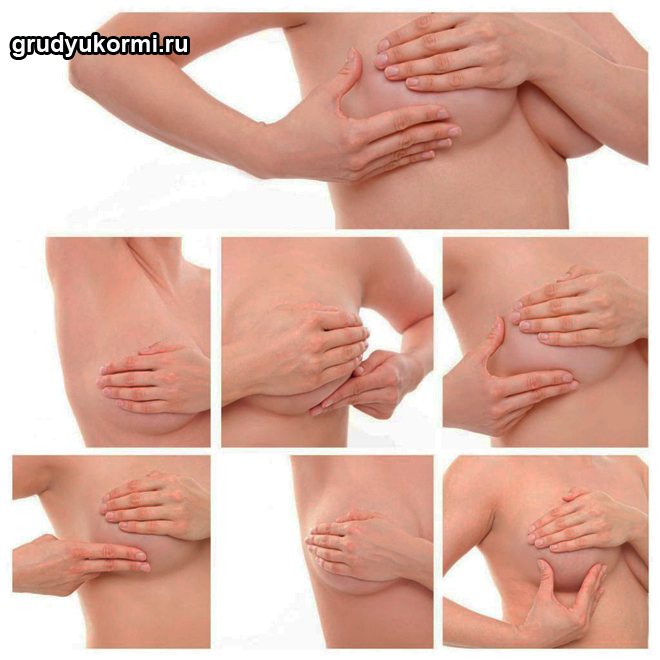
A young mother needs to eat well, properly and nutritiously. After giving birth, many people want to regain their pre-pregnancy weight as soon as possible. But at first, exercise is prohibited due to the possibility of bleeding. Afterwards, you can gradually introduce them, but do not overload yourself.
This is approximately how much a woman needs to eat without harm to her health.
Some features when feeding when the nipple is retracted
Firstly, the shape of a nipple with such a pathology impedes the flow of milk. To avoid this, doctors recommend using special devices. For example, a breast pump. It helps create a vacuum, which slightly stretches the nipple, slightly elevating it above the areola of the breast. In addition, the cap of the device itself has a special chamber into which the nipple must be placed. Under pressure, the nipple rises and occupies this “compartment”.
Secondly, often inverted nipples can cause mastitis, as well as other breast diseases. To avoid this, regularly pump out milk manually or mechanically (breast pump). Don't let breast milk clog your ducts. If it is very difficult and painful for a woman to endure the process of pumping, then consult a specialist. After all, often a young mother simply cannot overcome the pain that she causes herself in the process.
Thus, such a pathology leads to many problems. It is worth remembering the pitfalls. It is necessary to read as much literature on this issue as possible. After all, the situation of ignorance is very disarming. The topic “How to feed with inverted nipples” is in every book about preparing for the birth of a baby.
How to prepare your breasts for feeding a newborn

Pregnancy and childbirth are a very important moment in the life of every woman. It is clear that she will have a lot of worries and questions, especially if this is her first child. One of these questions is how to prepare the breasts for feeding so that there are no problems with lactation later. There are many methods and recipes for this, all of them are quite simple and with constant practice they bring beneficial results.
In the first year of life, a child should not be given a bottle of milk in bed.
Some parents are concerned if their baby continues to drink milk from a pacifier even in the second year of life, while other parents see nothing wrong with it. If you don't want your baby to drink milk from a pacifier after one year, don't give your baby a bottle of milk in bed. Between the 7th and 10th month, children often refuse to eat while sitting on their mother's lap; they want to hold the milk bottle themselves. A practical mother, seeing that her help is not needed, puts the child in a crib, where he drinks his own bottle of milk and then falls asleep. At first glance, this is a very cute sight. But some children, accustomed to a bottle of milk before bed, can no longer fall asleep without it. When later, at 15-18 or 21 months, the mother stops giving the baby milk from the nipple, he starts screaming and cannot sleep for a long time. This habit does not always develop. On the other hand, not giving your baby a bottle of milk will not speed up the transition from nipple to cup. Let the child hold a bottle of milk himself, but not in bed, but in your arms or at the table. And then put him in his crib to sleep.
